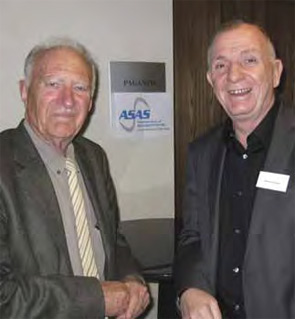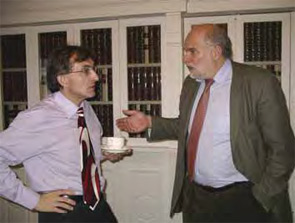Fifteen years ago, a small group of academic rheumatologists began meeting to discuss a common clinical interest in ankylosing spondylitis (AS). Their work launched a dialogue that has had an enormous impact on the field of rheumatology—and on the lives of people with AS. A disease with little in the way of common measurement tools, AS soon gained center stage in rheumatology as treatment with tumor necrosis factor (TNF) inhibitors showed dramatic results for this previously intractable condition. Those advances would not have been possible without the pioneering work of this dedicated group of international collaborators, according to members of the Assessment of SpondyloArthritis international Society (ASAS)’s Executive Committee and others in the rheumatology community.

What began as an initiative to develop core measures to assess improvement and remission in the context of clinical trials later blossomed into a whole new way of viewing the disease process itself. “I think ASAS really stepped into what was essentially a vacuum,” remarks John D. Reveille, MD, professor of internal medicine, Linda and Ronny Finger Foundation Distinguished Chair in Neuroimmunologic Diseases, and director of the division of rheumatology and clinical immunogenetics at the University of Texas Health Science Center in Houston. Dr. Reveille is also a member of the ASAS Advisory Board and president-elect of the Pan American League Against Rheumatism (PANLAR). “Nobody was addressing outcome measures in AS [at that time]—it was appalling.”
Small Steps
At the time ASAS was formed (it was then known as the ASsessments in Ankylosing Spondylitis working group), “people all over the world were using very different approaches to assess outcomes in spondyloarthritis, and there seemed to be relatively little consensus or systematic approach,” notes Dr. Walter P. Maksymowych, FRCP (C), a scientist at Alberta Heritage Foundation for Medical Research, professor of medicine at the University of Alberta in Edmonton, Canada, and a member of the ASAS Executive Committee.
The task that the core group of investigators set for themselves was to develop a core set of measures to assess effectiveness of drug therapy in patients with AS. ASAS Executive Committee secretary Martin Rudwaleit, MD, associate professor and director of the rheumatology department at the Evangelisches Krankenhaus in Hagen, Germany (formerly at Charité University Hospital in Berlin), was drawn to ASAS by colleagues Jürgen Braun and Joachim Sieper. They were members of the original group that convened along with other notable AS experts (Maxime Dougados and Désirée van der Heijde among them) in Amsterdam for the formative meeting. Dr. Rudwaleit notes that ASAS’ beginning coincided with the imminent release of newer nonsteroidal antiinflammatory drugs (NSAIDs) and the TNF blockers. “It became clear,” says Dr. Rudwaleit, “that we really needed standards for outcomes to measure therapeutic response.”
It was also obvious, adds Dr. Maksymowych, that there simply “weren’t a sufficient number of investigators in any one country to address the question of assessments. Therefore, it was important that we try and forge an international community of investigators who shared similar interests in outcome assessment and would work together. What ASAS is really about,” he explains, “is forging a common language that is accepted by people internationally.”
Timeline
1995 – First annual meeting convened at the EULAR Congress in Amsterdam by the Ankylosing Spondylitis working group
1997 – Preliminary core data sets identified
1999 – Selection of core set instruments
2001 – Preliminary definition of short-term improvement and partial remission in AS (ASAS 20 and ASAS partial remission)
2003 – ASAS recommendations on use of anti-TNF agents in AS8
2004 – Definition of improvement criteria (ASAS 40 and ASAD 5/6)9
2005 – FDA guidance document for conducting clinical trials in AS, an ASAS/SAA collaborative effort, is published
2006 – ASAS/EULAR recommendations for the management of AS10
2007 – Validation of scoring methods for MRI of the spine11
2009 – ASAS Handbook; criteria for axial spondyloarthritis published; ASDAS published; first ASAS educational workshop held in Rome12-14
2010 – Criteria for peripheral spondyloarthritis published
Meeting Unmet Needs
“We were lucky that this group of rheumatologists with an academic interest in ankylosing spondylitis and spondyloarthritis already existed and could really serve to fill in this gap and work on these unmet needs,” notes Dr. Rudwaleit.
Désirée van der Heijde, MD, PhD, professor of rheumatology at Leiden University Medical Center in Leiden, The Netherlands, a long-time investigator in the field and leader of the ASsessment in Ankylosing Spondylitis International Working Group, has been president of ASAS since its beginning. Fairly quickly, she recalls, the original ASAS group identified preliminary core sets for endpoints in AS. Using a literature search and small group meetings and plenary discussions, they identified five domains (physical function, pain, spinal mobility, spinal stiffness/inflammation, and the patient’s global assessment) to be used in the setting of symptom-modifying antirheumatic drugs in combination with physical therapy. At a later stage, the domain of fatigue was added. In the setting of clinical recordkeeping, two domains were added: acute phase reactants and peripheral joints/entheses.1 Finally, in the setting of disease-controlling antirheumatic therapy, assessment of spinal radiographs was added. After the selection of the domains, specific instruments for each domain were chosen.
Since its early days, ASAS has worked closely with OMERACT (Outcome Measures in Rheumatology, formerly Outcome Measures in Rheumatology Clinical Trials), subjecting their assessment instruments to the rigorous evaluation process of that organization. At the 1998 OMERACT conference, the selections made by ASAS were endorsed by OMERACT.2 The group then published their preliminary definition of short-term improvement and partial remission in AS3 and then used a three-round Delphi exercise with an expert panel to compare the specificity and sensitivity of the recently selected criteria to results from NSAID trials in 55 AS patients. The results of that exercise showed that the criteria did identify patients who were likely to be responders to drug therapies.4 Later, stricter criteria for improvement were defined.
David S. Hallegua, MD, assistant professor of medicine at Cedars-Sinai/UCLA School of Medicine in Los Angeles and past chair of the Spondylitis Association of America’s (SAA) Board of Directors, was part of the ASAS/SAA group convened in 2004 to generate a U.S. Food and Drug Administration (FDA) guidance document for conducting trials in AS.5 In that meeting, he says, the group used many of the measures that ASAS had developed in the previous 10 years. “The work they had already done helped the success of our meeting considerably,” Dr. Hallegua says. Another strength of the ASAS definitions of improvement in clinical trials: “While there is some emphasis on physician global assessment,” he says, “most of the measures, such as pain, inflammation, stiffness, and function, are patient derived.”

Giant Leap Forward—Changing the Dogma
As the group has strived for common-denominator assessment instruments, screening technology has also been a focus. For example, the advent of magnetic resonance imaging (MRI) opened the door for diagnosing patients earlier in the course of their disease. The New York criteria delay diagnosis until there are evident radiographic changes, a sequence that can take six to 10 years. Dr. van der Heijde explains that ASAS has made major efforts to propose clear definitions for abnormalities on MRI, both for the sacroiliac joints and the spine for use in clinical practice. For research purposes, various scoring methods for assessing MRI of the spine were compared, again with OMERACT endorsement. Recently, she says, the ASDAS has been published (see ASAS Timeline below). The ASDAS is a new disease activity score that has been proven to perform better than the existing disease assessment measures. The latest step was the definition of the cutoffs for clinically important improvement, major improvement, and the states of inactive disease (moderate, high, and very high disease activity). Again, these were endorsed by OMERACT at this year’s OMERACT 10 conference.
At their initial meeting in Amsterdam during the European League Against Rheumatism (EULAR) congress in 1995, the group’s aim was to devise core sets with which to assess patients in the clinical setting. But, as Dr. Reveille points out, “they were so successful in doing this that they began to look at the diseases themselves, forming a broader definition of the disease phenotype.”
Six years ago, Drs. Rudwaleit and Sieper proposed that the group embark on devising new criteria for spondyloarthritis. The new classification criteria for axial spondyloarthritis have been one of the major advances of the group’s rigorous, systematic approach and international consensus, says Dr. Maksymowych. “The combination of these small steps has really led to a gigantic step forward in terms of our ability to diagnose and manage this disease.”
“This was a long process,” admits Dr. Rudwaleit, from the time that he and Dr. Sieper first made their presentation to the group, then conducted a paper patient exercise to elicit expert opinion from international ASAS rheumatologists and finally to the initiations of the 25-center prospective study conducted by ASAS that ultimately resulted in the new classification criteria for axial spondyloarthritis.6,7 “It was really changing the dogma of ankylosing spondylitis, to focus instead on early disease and how to make that diagnosis and achieve consensus about that,” he says.

Strong Educational Agenda
Education is a necessary complement to the foundational research ASAS engages in, believes Dr. Rudwaleit. “Once we achieve consensus within ASAS—and we have very lively discussions, which are also quite controversial—then we usually publish and communicate our consensus to other colleagues.”
To enhance education, ASAS has developed educational material that is freely available at the ASAS website (www.asas-group.org). This includes the ASAS slide kit and the ASAS handbook, the latter of which contains detailed instructions on all the definitions and how to perform. The ASAS slide kit covers the entire spectrum of pathophysiology, clinical aspects, and outcome up to management. Since 2009, dedicated courses on all aspects of AS have been organized by ASAS for rheumatologists and fellows with a special interest in AS.
Dr. Maksymowych notes that the annual meetings also keep expanding. “We have a very active agenda at our meetings,” he adds. “The agenda is always being reinvigorated,” and the process of scientific debate continues. He notes that there is ongoing debate about the performance and acceptance of MRI measures of disease activity, a particular research interest of his, and that this is an evolving process.
ASAS also deliberately draws in researchers and clinicians from the developing countries as well as those from developed countries, states Dr. van der Heijde. Young researchers are encouraged through the offering of associate memberships. Once investigators have published five peer-reviewed publications on the topic, they can apply for full membership. The organization has established this formal requirement, notes Dr. Rudwaleit, “in order to make sure that we attract people who take it seriously.”

Challenges for the Future
The new classification criteria for both axial and peripheral spondyloarthritis constitute one of the most important advances of the last few years, says Robert B. M. Landewé, MD, professor of rheumatology in the department of internal medicine/ rheumatology at Maastricht University Medical Center in Maastricht, The Netherlands. Dr. Landewé’s main interests in clinical epidemiology, measurement, and assessment drew him to join ASAS when he finished his rheumatology training in Maastricht. “We now recognize that a patient may not meet the criteria for AS, but will have the same complaints, level of burden of illness, and be approximately similar,” he says.
Because the criteria are relatively new, the task of disseminating them will take some time and present challenges, Dr. Landewé notes. “Apparently, we still have to educate physicians seeing patients with low back pain or with other signs of spondyloarthritis in order to get those patients referred to where they belong—and that is to the rheumatologist.”
Educating colleagues, both in primary care and in rheumatology, is one of the future challenges. Dr. Rudwaleit thinks that ASAS will face challenges to define scientific projects that are attractive and interesting enough to the ASAS community to keep them “motivated and contributing. I think that the first 10 years were probably a little bit easier since we had many unfilled gaps,” he says. “Still, there are many unanswered questions such as that of the stimuli of bone formation in AS, the relationship of inflammation and bone formation, and the potential of modifying this process.”
Dr. Reveille believes there’s still plenty of work for ASAS and its methods in several other domains in AS. “Biomarkers, genetics, refinements in imaging—all of these elements will continue to develop, will need vetting, and will need to be incorporated into revisions of disease criteria,” Dr. Reveille asserts. “I also think we’re still struggling with some of the early disease definitions, not just in spondyloarthritis, and ASAS is extremely well suited to do that. They have, even at this point, no rivals.”
References
- van der Heijde D, Bellamy N, Calin A, et al. Preliminary core sets for endpoints in ankylosing spondylitis. J Rheumatol. 1997;24:2225-2229.
- van der Heijde D, Calin A, Dougados M, et al. Selection of instruments in the core set for DC-ART, SMARD, physical therapy, and clinical recordkeeping in ankylosing spondylitis. J Rheumatol. 1999;26:951-954.
- Anderson JJ, Baron G, van der Heijde D, et al. Ankylosing Spondylitis Assessment Group preliminary definition of short-term improvement in ankylosing spondylitis. Arthritis Rheum. 2001;44:1876-1886.
- van Tubergen A, van der Heijde D, Anderson J, et al. Comparison of statistically derived ASAS improvement criteria for ankylosing spondylitis with clinically relevant improvement according to an expert panel. Ann Rheum Dis. 2003;62:215-221.
- van der Heijde D, Dougados M, Davis J, et al. Assessment in Ankylosing Spondylitis International Working Group/Spondylitis Association of America recommendations for conducting clinical trials in ankylosing spondylitis. Arthritis Rheum. 2005;52:386-394.
- Rudwaleit M, Landewé R, van der Heijde D, et al. The development of Assessment of SpondyloArthritis International Society classification criteria for axial spondyloarthritis (part I): Classification of paper patients by expert opinion including uncertainty appraisal. Ann Rheum Dis. 2009;68:770-776.
- Rudwaleit M, van der Heijde D, Landewé R, et al. The development of Assessment of SpondyloArthritis international Society classification criteria for axial spondyloarthritis (part II): Validation and final selection. Ann Rheum Dis. 2009;68:777-783.
- Braun J, Pham T, Sieper J, et al. International ASAS consensus statement for the use of anti-tumour necrosis factor agents in patients with ankylosing spondylitis. Ann Rheum Dis. 2003;62:817-824.
- Brandt J, Listing J, Sieper J, et al. Development and preselection of criteria for short-term improvement after anti-TNF (alpha) therapy in ankylosing spondylitis. Ann Rheum Dis. 2004;63:1438-1444.
- Zochling J, van der Heijde D, Burgos-Vargas R, et al. ASAS/EULAR recommendations for the management of ankylosing spondylitis. Ann Rheum Dis. 2006; 65:442-452.
- van der Heijde D, Landewé R, Hermann KG, et al. ASAS/OMERACT MRI in AS Working Group. Is there a preferred method for scoring activity of the spine by magnetic resonance imaging in ankylosing spondylitis? J Rheumatol. 2007; 34:871-873.
- Sieper J, Rudwaleit M, Baraliakos X, Brandt J, et al. The Assessment of SpondyloArthritis international Society (ASAS) handbook: A guide to assess spondyloarthritis. Ann Rheum Dis. 2009; 68:ii1-ii44.
- Lukas C, Landewé R, Sieper J, et al. Development of an ASAS-endorsed disease activity score (ASDAS) in patients with ankylosing spondylitis. Ann Rheum Dis. 2009;68:18-24.
- van der Heijde D, Lie E, Kvien TK, et al. The ASDAS is a highly discriminatory ASAS-endorsed disease activity score in patients with ankylosing spondylitis. Ann Rheum Dis. 2009; 68:1811-1818.
